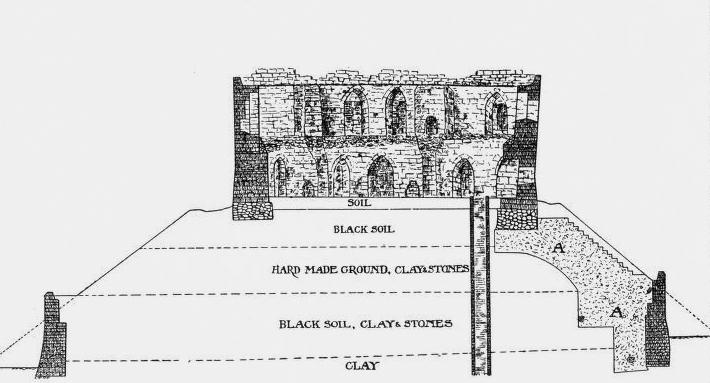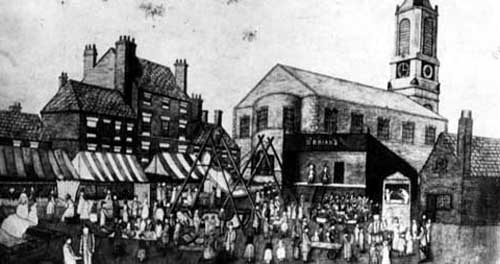|
York Crown Court
York Crown Court is a Crown Court venue which deals with criminal cases at York Castle in York, England. It is a Grade I listed building. History Originally the assizes for the City of York were held in York Guildhall in St Martins Courtyard, Coney Street. However, judicial matters moved to York Castle when a Grand Jury House was built there in 1668 and supplemented by a Sessions House of 1675. However, by the mid 18th century, the Grand Jury House had become dilapidated and it was decided to demolish it and to erect a new building on the same site. The new building was commissioned to serve as the assizes courts for the City of York. It was designed by John Carr in the neoclassical style, built in ashlar stone and was completed in 1777. The design involved a symmetrical main frontage of thirteen bays, with single-storey end bays which were slightly recessed: it faced onto the castle courtyard, which was grassed over at that time to form a circle, which became known as the ... [...More Info...] [...Related Items...] OR: [Wikipedia] [Google] [Baidu] |
York Castle
York Castle is a fortified complex in the city of York, England. It consists of a sequence of castles, prisons, law courts and other buildings, which were built over the last nine centuries on the south side of the River Foss. The now-ruined keep of the medieval Norman castle is commonly referred to as Clifford's Tower. Built originally on the orders of William I to dominate the former Viking city of Jórvík, the castle suffered a tumultuous early history before developing into a major fortification with extensive water defences. After a major explosion in 1684 rendered the remaining military defences uninhabitable, York Castle continued to be used as a jail and prison until 1929. The first motte and bailey castle on the site was built in 1068 following the Norman conquest of York. After the destruction of the castle by rebels and a Viking army in 1069, York Castle was rebuilt and reinforced with extensive water defences, including a moat and an artificial lake. York Castle f ... [...More Info...] [...Related Items...] OR: [Wikipedia] [Google] [Baidu] |
Pediment
Pediments are gables, usually of a triangular shape. Pediments are placed above the horizontal structure of the lintel, or entablature, if supported by columns. Pediments can contain an overdoor and are usually topped by hood moulds. A pediment is sometimes the top element of a portico. For symmetric designs, it provides a center point and is often used to add grandness to entrances. The tympanum, the triangular area within the pediment, is often decorated with a pedimental sculpture which may be freestanding or a relief sculpture. The tympanum may hold an inscription, or in modern times, a clock face. Pediments are found in ancient Greek architecture as early as 600 BC (e.g. the archaic Temple of Artemis). Variations of the pediment occur in later architectural styles such as Classical, Neoclassical and Baroque. Gable roofs were common in ancient Greek temples with a low pitch (angle of 12.5° to 16°). History The pediment is found in classical Greek temples, Et ... [...More Info...] [...Related Items...] OR: [Wikipedia] [Google] [Baidu] |
Buildings And Structures In York
A building, or edifice, is an enclosed structure with a roof and walls standing more or less permanently in one place, such as a house or factory (although there's also portable buildings). Buildings come in a variety of sizes, shapes, and functions, and have been adapted throughout history for a wide number of factors, from building materials available, to weather conditions, land prices, ground conditions, specific uses, prestige, and aesthetic reasons. To better understand the term ''building'' compare the list of nonbuilding structures. Buildings serve several societal needs – primarily as shelter from weather, security, living space, privacy, to store belongings, and to comfortably live and work. A building as a shelter represents a physical division of the human habitat (a place of comfort and safety) and the ''outside'' (a place that at times may be harsh and harmful). Ever since the first cave paintings, buildings have also become objects or canvasses of much artistic ... [...More Info...] [...Related Items...] OR: [Wikipedia] [Google] [Baidu] |
Government Buildings Completed In 1777
A government is the system or group of people governing an organized community, generally a state. In the case of its broad associative definition, government normally consists of legislature, executive, and judiciary. Government is a means by which organizational policies are enforced, as well as a mechanism for determining policy. In many countries, the government has a kind of constitution, a statement of its governing principles and philosophy. While all types of organizations have governance, the term ''government'' is often used more specifically to refer to the approximately 200 independent national governments and subsidiary organizations. The major types of political systems in the modern era are democracies, monarchies, and authoritarian and totalitarian regimes. Historically prevalent forms of government include monarchy, aristocracy, timocracy, oligarchy, democracy, theocracy, and tyranny. These forms are not always mutually exclusive, and mixed governme ... [...More Info...] [...Related Items...] OR: [Wikipedia] [Google] [Baidu] |
Crown Court Buildings
A crown is a traditional form of head adornment, or hat, worn by monarchs as a symbol of their power and dignity. A crown is often, by extension, a symbol of the monarch's government or items endorsed by it. The word itself is used, particularly in Commonwealth countries, as an abstract name for the monarchy itself, as distinct from the individual who inhabits it (that is, ''The Crown''). A specific type of crown (or coronet for lower ranks of peerage) is employed in heraldry under strict rules. Indeed, some monarchies never had a physical crown, just a heraldic representation, as in the constitutional kingdom of Belgium, where no coronation ever took place; the royal installation is done by a solemn oath in parliament, wearing a military uniform: the King is not acknowledged as by divine right, but assumes the only hereditary public office in the service of the law; so he in turn will swear in all members of "his" federal government''. Variations * Costume headgear imitati ... [...More Info...] [...Related Items...] OR: [Wikipedia] [Google] [Baidu] |
Grade I Listed Buildings In The City Of York
There are over 9,000 Grade I listed buildings in England. This page is a list of these buildings in the City of York in North Yorkshire. List of buildings See also * Grade II* listed buildings in the City of York *Grade I listed buildings in North Yorkshire ** Grade I listed buildings in Selby (district) ** Grade I listed buildings in Harrogate (borough) ** Grade I listed buildings in Craven ** Grade I listed buildings in Richmondshire ** Grade I listed buildings in Hambleton ** Grade I listed buildings in Ryedale ** Grade I listed buildings in Scarborough (borough) ** Grade I listed buildings in Redcar and Cleveland ** Grade I listed buildings in Middlesbrough (borough) ** Grade I listed buildings in Stockton-on-Tees Notes External links {{GradeIListedbuilding Grade I listed buildings In the United Kingdom, a listed building or listed structure is one that has been placed on one of the four s ... [...More Info...] [...Related Items...] OR: [Wikipedia] [Google] [Baidu] |
Death Comes To Pemberley (TV Series)
''Death Comes to Pemberley'' is a three-part British television drama based on the best-selling 2011 P.D. James novel of the same name. Her murder mystery was based on the style and characters of Jane Austen's 1813 novel ''Pride and Prejudice.'' The series was commissioned by Controller of BBC Drama Commissioning Ben Stephenson and then-Controller of BBC One Danny Cohen, and was first broadcast from 26 to 28 December 2013 on BBC One. Premise It is June 1803, six years after the marriage of Mr. Fitzwilliam Darcy and Miss Elizabeth Bennet, as recounted in ''Pride and Prejudice.'' One evening, George Wickham and his wife Lydia (Elizabeth's sister) are travelling by carriage to Pemberley for a ball with Captain Denny. Wickham and Denny have an argument, and leave the carriage in anger. The two men disappear into the woodland, where Lydia hears two gunshots. After being informed, Darcy sends out a search party, who find Wickham distraught and hysterical, holding Denny's body and ... [...More Info...] [...Related Items...] OR: [Wikipedia] [Google] [Baidu] |
Michael Rankine
Michael Lee Rankine (born 15 January 1985) is an English former professional footballer who played as a striker. He played in the Football League for Scunthorpe United, AFC Bournemouth, Aldershot Town and York City. Rankine began his career with the Doncaster Rovers youth system, before playing for Armthorpe Welfare and Barrow in non-League football. He moved to League Two club Scunthorpe United in 2004 but after only scoring one goal for them signed for Alfreton Town. He signed for Conference National club Rushden & Diamonds in 2006, where he played for three seasons, before signing for divisional rivals York City in 2009. He played for them in the 2010 Conference Premier play-off Final before signing for Aldershot Town in 2011. He spent two seasons at Aldershot and during that time had loan spells with Grimsby Town and York. After a season with Hereford United he signed for Gateshead in 2014. Career Early career Born in Doncaster, South Yorkshire, Rankine started his car ... [...More Info...] [...Related Items...] OR: [Wikipedia] [Google] [Baidu] |
Craig Nelthorpe
Craig Robert Nelthorpe (born 10 June 1987) is an English semi-professional footballer who plays as a left back or left winger for club Belper Town. He has played in the Football League for Doncaster Rovers and Darlington. Nelthorpe played for Brodsworth Miners Welfare and Frickley Athletic before joining Doncaster Rovers in 2004 and he made his first-team debut in 2005. He was loaned out on six occasions, playing for Hucknall Town, Kidderminster Harriers, Gateshead, Halifax Town and Darlington. He joined Oxford United in 2009 and after being released by them he joined York City. Having left York after a season he rejoined Gateshead. Career Doncaster Rovers Nelthorpe played for Brodsworth Miners Welfare before joining Northern Premier League Premier Division club Frickley Athletic in April 2004. He made his debut as a 74th minute substitute in a 2–1 defeat at Vauxhall Motors on 3 April 2004. He made three appearances for Frickley before he joined the Doncaster Rove ... [...More Info...] [...Related Items...] OR: [Wikipedia] [Google] [Baidu] |
Courts Act 1971
The Courts Act 1971 is an Act of the Parliament of the United Kingdom, the purpose of which was to reform and modernise the courts system of England and Wales. It established the Crown Court, introduced the posts of circuit judge and recorder, and abolished various local courts across the country. Many of its provisions have since been repealed by the Senior Courts Act 1981, but the essential structure described in the Act is still in place. The first part of the Act concerns the new Crown Court. It is established as part of the Supreme Court of Judicature, replacing courts of assize and quarter sessions. The appellate jurisdiction of these courts is transferred, and the new court given exclusive jurisdiction in "trial on indictment". It is described as a "superior court of record" for England and Wales. This section has now been superseded by the Senior Courts Act 1981. History ''Report of the Royal Commission on Assizes and Quarter Sessions'' (Sessional Papers, House of ... [...More Info...] [...Related Items...] OR: [Wikipedia] [Google] [Baidu] |
Glassblowing
Glassblowing is a glassforming technique that involves inflating molten glass into a bubble (or parison) with the aid of a Blowpipe (tool), blowpipe (or blow tube). A person who blows glass is called a ''glassblower'', ''glassmith'', or ''gaffer''. A ''lampworking, lampworker'' (often also called a glassblower or glassworker) manipulates glass with the use of a torch on a smaller scale, such as in producing precision laboratory glassware out of borosilicate glass. Technology Principles As a novel glass forming technique created in the middle of the 1st century BC, glassblowing exploited a working property of glass that was previously unknown to glassworkers; inflation, which is the expansion of a molten blob of glass by introducing a small amount of air into it. That is based on the liquid structure of glass where the atoms are held together by strong chemical bonds in a disordered and random network,Frank, S 1982. Glass and Archaeology. Academic Press: London. Freestone, I. (1 ... [...More Info...] [...Related Items...] OR: [Wikipedia] [Google] [Baidu] |
Trial Of Mary Fitzpatrick
The trial of Mary Fitzpatrick of November 1882, before Justice Henry Hawkins, was an English murder and robbery case at the York Winter Assizes in the assize courts at York Castle, which drew much attention in contemporary newspapers. It followed the death of 24-year-old glass blower James Richardson, who was last seen alive in the company of rag sorter Mary Fitzpatrick, aged 23, and was next seen dead in the water without his watch and chain. The Coroner's Court returned a verdict of "wilful murder." Fitzpatrick and Richardson lived in slum areas of Leeds; Fitzpatrick was tried by at least five aristocrats. She was convicted of robbery, and sentenced to penal servitude for six years. At the time of the trial she had two young children. Mary Fitzpatrick, perpetrator Mary Fitzpatrick (b.1855–1859) née Corcoran, alias Mary Anne Gollagher, was born in Leeds, West Riding of Yorkshire, England. She was the daughter of Richard Corcoran (b.ca.1829) a greengrocer and labourer, and h ... [...More Info...] [...Related Items...] OR: [Wikipedia] [Google] [Baidu] |







